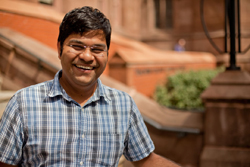The Answer Man
Pranav Garg is EdLab's programming ace
If you want to know what makes Pranav Garg tick, start with his job title: Solutions Architect.
That label accurately describe Garg’s role at EdLab, the creative services unit within TC’s Gottesman Libraries. Day to day, Garg oversees the library’s technical infrastructure, fixing systems when they crash. Long term, he brainstorms with other members of the EdLab team to come up with innovative new software that does everything from help new students get around TC to enable professors to conduct threaded discussions of YouTube videos.
But Garg has been problem-solving through programming since he was a sixth grader in India, using Lego and Basic to create on-screen simulations of a rocket launch.
“It was on-the-job learning,” he says “How to get groups of pixels to move up, or to look like flames coming out of the back of the rocket.”
He became intrigued enough with computers to take a programming course outside of school. “What really hooked me was that you could delegate repetitive work to the computer – like erasing words in word processing – and be free to concentrate on more interesting stuff.”
The “stuff” got way more interesting in the mid-1990s, with the advent of the Web, which rapidly became a tool for doing business. Garg spent five years as a software developer and problem solver in the financial services field, working for the India divisions of Morgan Stanley, Microsoft and InfoSys. He led small teams working on projects that involved hundreds of people, such as corporate infrastructure migrations and the development of daily reporting systems that enable stock traders to know that their transactions have gone through. On one level it was exciting stuff: when systems went down, Garg’s teams knew their work could save customers literally millions of dollars per minute.
“But ultimately I felt my life was getting too sedentary, that I wasn’t fully using my potential,” he says. “In big organizations, it takes years before you get to really lead or share your ideas or get substantial recognition for things you’ve developed. So I wanted to get out of my comfort zone.”
He came to the United States to attend Columbia University’s master’s degree program in Computer Science. There he became particularly interested in the predictive technologies employed by companies such as Amazon.
“How did they know, based on your purchase of this product here, that you’d be interested in that one, there?” he says. “I wanted to understand the programs they were using behind that. And the more I studied it, the more I began to get ideas.”
Perhaps as a direct result of that period of inquiry, Garg has helped develop a suite of related tools at Ed Lab that draw on the user’s profile and track record of choices to help facilitate choices about courses to take, people to meet, and other decisions that dictate the quality of the TC experience.
“What I love about working at EdLab is that there’s really the freedom to apply your ideas,” he says. “Management is open enough to say, ‘We like that, do a prototype.’ It’s also great that we have researchers there who can guide our work. Because I’m a computer sciences guy – I don’t have a deep knowledge of the education sector. Our researchers can say, here’s something students or faculty really need – and then we can go design a solution.”
That was the process that led Garg and his coworkers to develop Vialogues, the new tool that allows an online discussion group to upload videos and key in on specific moments that are of particular interest. “Basically, people were saying, We need something that can really make use of video in a more targeted way, and that also enables people to work at their own pace at home. So we created that.”
Not all of the ideas Garg has pursued at Ed Lab have come to fruition. A few years ago, together with colleagues, he developed I-phone application that could translate text in photographic images into other languages. The technology – which involved routing the photographic information to a computer at Ed Lab with translation capabilities – worked well, but the project was derailed by legal issues. Later on, Google developed and brought to market an app that does basically the same thing.
Garg remains undeterred by such setbacks. “We’re not in this to make a profit,” he says. “We want to build a suite of applications that can serve people in the education sector, so that they can share information and create better ideas. And we want to keep improving their experience using our tools so they can make more intelligent choices.”
Published Thursday, Aug. 18, 2011
